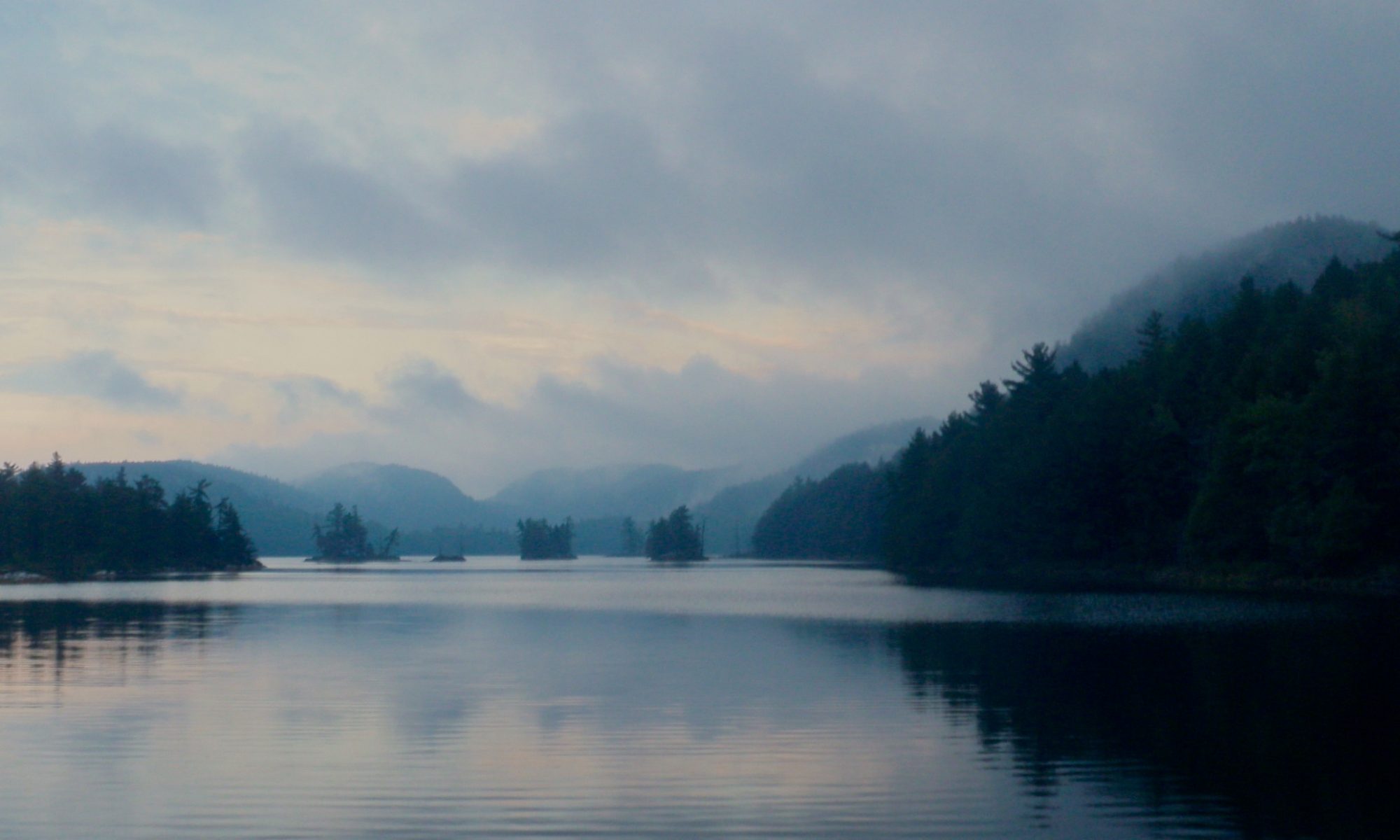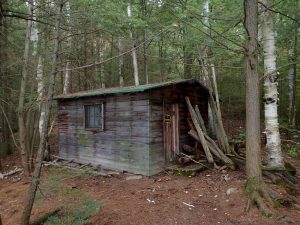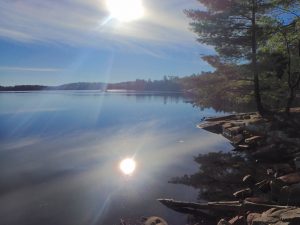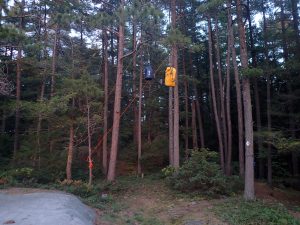Every year Mike and I drive from southern Ontario to Killarney to do some backcountry snowshoeing. This is our second trip this year, and we brought Andy along for the first time. We typically choose the peak of one of the hills as our destination. Killarney has incredible scenery, and the smooth quartzite ridges make the vegetation sparse enough for easy bushwhacking. That said it’s usually a challenging day, bookended by two five hour drives.
We were starting to run out of fresh destinations. There aren’t that many off trail peaks within a half days walk of an access point. This year we were targeting one of the peaks on the northwest shore of Killarney Lake. Mike and I had snowshoed up the nearby hill that looms to the north of O.S.A. Lake a few years back, and Xander and I had climbed the ridge to the east of the portage between Killarney Lake and Threenarrows lake while on a Thanksgiving canoe trip. That left the peak in the middle, on the west side of portage. It’s a bit far for a day trip, but the area can be accessed by following “The Crack” trail, then following the portage from Kakakise Lake to Killarney Lake, and finally crossing the frozen lake to base of the hill.
It might seem like the cold would be a challenge on a trip like this, but warm weather can post even more problems at this time of the year. Not only is overheating an issue, but a lot of the terrain becomes quite difficult when the snow and ice start to melt. We had an unseasonably warm day and the temperature almost made it to nine degrees celcius. On the up side we had clear blue skies which afforded us some spectacular views.
The Trail
The first section of trail from the parking lot to the Silhouette Trail is a pretty easy walk. This area sees some visitors all year round, and the trail up to “The Crack” is a popular destination in the winter. We encountered a couple heading out from the parking lot. They were loading up their sled for an overnight camping trip, and like us they were a bit worried about the warm weather.
Our path followed The Silhouette Trail briefly before we reached Kakakise Lake. The Silhouette is a multi day hiking trail around the park, and most of it is quite rugged, so it’s surprising that it’s so easy along this little stretch. Our first challenge was the portage from Kakakise Lake to Killarney Lake. This is a pretty rough portage in the summer, but in the winter it’s a bit easier. The trail was far less travelled than the one to “The Crack” but someone had passed this way before us. Parts of the trail are a creek in the summer, and there was open water showing through the snow in places. The snow was compacting well, but it was so sloppy that we’d still slip from time to time. Even through the skies were clear we were being rained on from the snow melting off of the trees.
The Lakes
We had to cross two sections of Killarney Lake and I was starting to worry about the condition of the ice. When we finally spotted the lake below us a trick of the light made the shadows appear to be open water. There was some open water near shore, and I did go right through the soft ice in the shallows with one foot, but it felt much more solid once we got on the lake. We still took care to spread out so that all of our weight wasn’t in one area.
It was surprisingly windy out on the ice. It certainly wasn’t cold, but it was pretty loud at times. This part of Killarney Lake is one of my favourite places to paddle in the park, and it’s also a pretty spectacular view in the winter. When canoeing we have to paddle around the small peninsula that separates the southern part of the lake from the main body of water, but on snowshoes we could cut right across it before the walk to the base of the hill. The snow on top was starting to get slushy, but the ice beneath still felt solid.
We were almost on the far shore of the lake when we came across a huge trail of tracks. We hadn’t seen any signs of humans since leaving the Kakakise portage. These were wolf tracks, travelling perpendicular to our direction. They had been travelling mostly single file, but then they had spread out in one spot before regrouping. We wondered if they had been hunting something but couldn’t find any other signs, so we surmised that they were playing or challenging one another as they crossed the lake and had a bit of a tussle.
First Climb
We encountered more wolf tracks in the woods on the far side of the lake as we started to climb the hilll. We were travelling up a saddle between the two peaks. It wasn’t particularly steep at this point and the snow was nice and firm. There was a pond above us, and I was hoping we could find a creek to follow where it drained. Creeks usually carve shallower slopes into the sides of the hill and make an easier trail to the top.
The terrain started to get steeper and we were soon having to work harder and pick our path more carefully to make our way around the large rocks. But we were also getting glimpses of a view behind us as we got higher. At first we could just see Killarney Lake, but we were soon high enough to see O.S.A. Lake as well. The woods are really thin here so the views are excellent. Even though this is a relatively gentle slope up the hill, it’s relentless. Each ridge falls away to reveal another ridge behind it.

We found the creek I had been looking for, and soon an impressive frozen waterfall. The ice was dripping, and when we returned later in the day an impressive amount of it was gone. We were able to walk along the base of the pretty wall of ice and then follow a steep trail up to the top on the other side. As we climbed up a steep slope above the waterfall Andy’s snowshoes gave out and slipped on the snow. I was behind him and grabbed his shoe so that he’d have something to push against. Mike and I have MSR Ascent snowshoes which have excellent traction in these conditions, but Andy had rented a pair of Atlas shoes at the campground. They’re ok shoes, but not nearly as grippy. By pushing off of my hand Andy was able to make it to where Mike was above him.
At the top of this steep climb we were rewarded with a nice view perched high above O.S.A. Lake. We stopped to admire it before pushing on up the hill. From here up to the first peak the views just kept getting better and better. Thanks to the sparse tree cover we could enjoy the scenery as we climbed. It has to be one of the best climbs we’ve done for quantity and quality of the views all the way up.
The Pond
After enjoying the view from the lookout we turned back into the trees. It wasn’t nearly as steep here, but we were still climbing. We were now heading into the interior of the park, towards Threenarrows Lake, heading for the highest point on the hill. The portage from Killarney to Threenarrows is three kilometres long, and we were now paralleling its path.
We finally found the pond I’d been searching for, and crossed the ice to the other side. These ponds can have bad ice because of shallow water and the warmth generated by decaying vegetation. The ice of this pond was fortunately sound, but the snow on top had a powdery quality we hadn’t encountered much of that day.
Once we crossed the pond I led us up a false peak, and then we had to descend back into a valley before ascending the true peak. To climb out of the valley we had to follow a very steep gulley. The valley was littered with small boulders of snow that had formed when snowballs had rolled down the slope and gathered more snow as they rolled down. If it weren’t for where we were I would have thought that someone had been making an army of snowmen.
First Peak

It was a tough climb up the gulley, and when we got to the top we got our first view in a long time. We were now far into the hills, and the lakes were off in the distance. We stopped for a break and I realized that my snowshoes were covered in water drops because of the melting snow.
The rest of the climb to the peak was mercifully gradual, and we soon found ourselves looking down in all directions. Or almost. There was another peak a little further along the ridge. It was really hard to tell which was the tallest from where we stood, and they were close enough that my topo map didn’t make it clear which was taller. The second peak was another 600m away, but after some hemming and hawing and an impromptu vote we decided to press on to the last peak ‘just in case’.
Second Peak

The trip from the first peak to the second peak was reasonably easy, even if it did mean we had to descend into another valley and then climb back up again. But it was all gradual slopes, and the final ascent was almost devoid of trees. A large erratic was perched almost at the top of the mountain and guided our way to the top. We had a 360 degree view, and could see a glimpse of O.S.A. Lake on one side and a sliver of Threenarrows Lake on the other. It looked like a sea of foothills spread out below us. It wasn’t as impressive a view as we’d had earlier, but it felt more remote.
I climbed a boulder just to say I’d reached the highest point, and we took a group photo to commemorate the occasion. We were scanning around plotting our return trip when I realized that we still hadn’t reached the point we’d been heading for. I’d been navigating to a waypoint on the map that was another 300m away! We debated going on again, but this time it really did seem like we were at the top, so we decided to turn back.
Dead End
As we’d climbed the last peak Mike and I had discussed returning via a different path. From where we were standing it looked like we could take a ‘short cut’ that would lead us down into the valley below which would mean less climbing up and down. When we got off the peak we turned to the right and abandoned the trail we’d cut on the way in. We soon found ourselves blocked by a vertical cliff, so we turned and followed the top of the ridge. At the very least we’d avoid having to climb all the way up to the top of the second peak again.
We found a promising looking ridge that dropped over the edge and descended across the face of the cliff at a gentle slope. The map even indicated that there was likely to be a more gradual slope ahead, so we decided to descend through the pass and then follow the ridge down. We made it about a third of the way down the cliff, but the ledge we were on kept getting narrower and narrower. It finally just disappeared at a drop off. Amazingly there were trees growing all over this ledge, but there was nothing that we could hold onto, and we were still very high above the valley below.
Reluctantly we turned around and climbed back up the hill. It was disheartening, but we still had plenty of energy and it was still a spectacular day. We continued along the ridge, which isn’t as easy as it sounds. We had to pick our path carefully to avoid getting caught in other dead ends like the last one. Because we were right at the edge of the cliff the views were still spectacular and there were frequent lookouts.
Climb Down
We finally found the trail that we made on the way in, and rejoined it for the descent from the first peak. We contemplated another ‘short-cut’ on the way down, but in the end we just retraced our footsteps. We were going down so it wasn’t nearly as hard as going up. It was still early enough that we had plenty of light, the sun was turning golden, and now we were facing the direction of all of the spectacular views.
It’s a good thing that we were heading down, because we were all starting to feel pretty tired by this point. We were all pretty relieved when we finally made it down to the ice of Killarney Lake. We made it to the ice twenty-five minutes before sunset.
The Return
We spread out on the lake again, and we could see that our tracks from earlier in the day were dark with melt. We could feel the slush beneath our snowshoes. I kept reminding myself that there still had to be at least nine inches of ice on the lake. But if we couldn’t cross the lake we’d have to walk around it, and that would add a lot of extra distance to an already long trip. As we crossed into the widest part of the lake I realized that we could see puddles on the snow, and this time they weren’t a trick of the light. The wolf tracks that we’d seen earlier were almost completely melted away.
We abandoned our track from earlier and turned to get to shore more quickly. We climbed up some rocks at a campsite. The ground was more solid, but the going was pretty rough in here. We still had to cross the peninsula to the southern bay. We decided to chance it on the ice again, staying away from shore as we headed back to the narrow part of the peninsula.
We made it to the southern bay as the glow of the sunset was fading from yellow to dark blue. We really started to slow down on this last stretch. Mike and I have done this a few times, and while we were by no means immune to the agony we weren’t feeling it as badly as Andy. He’d fall behind us, and we’d wait for him to catch up. As soon as he did we’d start up again, leaving him no time to catch his breath.
We finally got off the ice at 6:12. The sun had set a long time ago, but there was a still a bit of light in the sky. After the easy travel on the ice the portage was pretty brutal, and it was completely dark by the time we made it back to the easier trail. By then we were all pretty beat, and we had to pace ourselves. It took us another hour to finish the ‘easy’ trail and make it back to the car.
Tips
- If you do this as a day trip you’ll have to purchase a day pass from the park office for parking your vehicle. In the winter you can park at the trailhead for access to ‘The Crack’. In the summer you’ll have to put in at George Lake and cross Freeland Lake to get to Killarney Lake.
- If you make the trip part of a backcountry camping excursion to Killarney Lake you’ll have to book far in advance unless you go in the shoulder seasons. Killarney is one of the busiest lakes in the park.
- If you do the trip in the winter you can rent snowshoes from The Friends Of Killarney Park at the camp office where you pick up your permit.
- This trip is an excellent (and challenging) snowshoe trip, but it would also make a great day excursion while camped on Killarney Lake.










